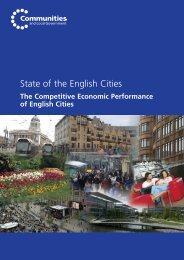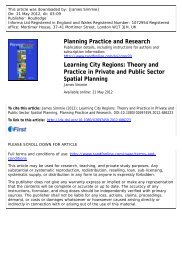History Matters: Path dependence and innovation in British city ...
History Matters: Path dependence and innovation in British city ...
History Matters: Path dependence and innovation in British city ...
You also want an ePaper? Increase the reach of your titles
YUMPU automatically turns print PDFs into web optimized ePapers that Google loves.
Figure 5: <strong>Path</strong> <strong>dependence</strong>, local <strong><strong>in</strong>novation</strong> systems <strong>and</strong> absorptive capa<strong>city</strong><br />
Economic<br />
development<br />
<strong>Path</strong> <strong>dependence</strong><br />
<strong>Path</strong> creation<br />
Absorptive<br />
capa<strong>city</strong><br />
Knowledge:<br />
Identification<br />
Assimilation<br />
Exploitation<br />
Local <strong><strong>in</strong>novation</strong><br />
system<br />
Knowledge:<br />
Creation<br />
Adoption<br />
Commercialisation<br />
pathways. Patel <strong>and</strong> Pavitt (1997) argue that<br />
the ma<strong>in</strong> <strong><strong>in</strong>novation</strong> actors – firms – develop<br />
most of their new technologies <strong>in</strong>-house by<br />
modify<strong>in</strong>g processes alongside contributions<br />
from other firms <strong>and</strong> the science base. Most<br />
of the time firms build <strong>and</strong> improve upon their<br />
exist<strong>in</strong>g technological base. Patel <strong>and</strong> Pavitt<br />
call this technological accumulation.<br />
Branch<strong>in</strong>g out of exist<strong>in</strong>g <strong>in</strong>dustries <strong>in</strong>to new<br />
but technologically related activities can<br />
also create new pathways. Some firms, for<br />
example 3M, are well known for pursu<strong>in</strong>g such<br />
a strategy. Over the years it has developed its<br />
basic adhesive technology from produc<strong>in</strong>g s<strong>and</strong><br />
paper <strong>and</strong> Post-It notes to plasma screens.<br />
The <strong>British</strong> motor sport <strong>in</strong>dustry has also<br />
developed close to areas with generic skills <strong>in</strong><br />
the mass production car <strong>in</strong>dustries, particularly<br />
Birm<strong>in</strong>gham, Coventry <strong>and</strong> Oxford (P<strong>in</strong>ch <strong>and</strong><br />
Henry, 1999).<br />
New pathways can also be created by<br />
upgrad<strong>in</strong>g exist<strong>in</strong>g <strong>in</strong>dustries. In this scenario,<br />
exist<strong>in</strong>g <strong>in</strong>dustries are revitalised <strong>and</strong> enhanced<br />
by the <strong>in</strong>fusion of new technologies or the<br />
<strong>in</strong>troduction of new products <strong>and</strong> services.<br />
This evolution is not easy. Some of the few<br />
rema<strong>in</strong><strong>in</strong>g furniture manufacturers <strong>in</strong> High<br />
Wycombe have achieved such change by<br />
add<strong>in</strong>g the organisation of the furnish<strong>in</strong>g of<br />
entire office blocks to their manufactur<strong>in</strong>g<br />
activities. Generally, however, firms can do only<br />
a few th<strong>in</strong>gs well at any one time; their learn<strong>in</strong>g<br />
capabilities are equally constra<strong>in</strong>ed (Nelson<br />
1995, p. 79).<br />
1.3 The application of long-term<br />
historic analysis to underst<strong>and</strong><strong>in</strong>g the<br />
development of <strong>city</strong>-regional economies<br />
The analysis of the long-term development of<br />
<strong>city</strong>-region economies requires an analysis of<br />
three <strong>in</strong>terrelated phenomena. These are the<br />
structural evolution of the economy, <strong>in</strong>clud<strong>in</strong>g<br />
the decl<strong>in</strong>e or ma<strong>in</strong>tenance of old sectors<br />
<strong>and</strong> the creation of new ones; the capa<strong>city</strong> to<br />
identify, assimilate <strong>and</strong> exploit new knowledge;<br />
<strong>and</strong> the <strong>in</strong>digenous creation, adoption <strong>and</strong><br />
commercialisation of new knowledge. Each of<br />
these phenomena has its own conceptual <strong>and</strong><br />
measurement problems. The overall structure of<br />
the analysis is illustrated <strong>in</strong> Figure 5.<br />
Economic development<br />
Unless development takes place <strong>in</strong> previously<br />
underdeveloped localities, such as North West<br />
Engl<strong>and</strong> before the Industrial Revolution or<br />
Santa Clara County before the ICT revolution,<br />
then their economic pathways are highly<br />
dependent on their previous economic<br />
histories. The structural characteristics of<br />
previous eras determ<strong>in</strong>e many of the possible<br />
directions of future development, mak<strong>in</strong>g many<br />
local economic changes path dependent.<br />
15













